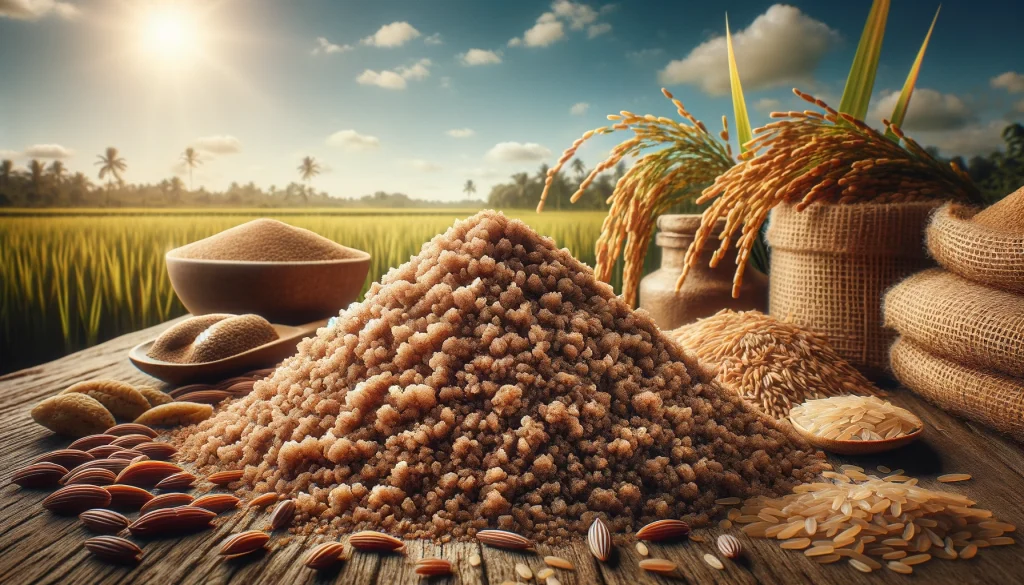As an Amazon Associate I earn from qualifying purchases.
Stabilized rice bran, a powerhouse of nutrition, emerges from the outer layer of the rice kernel, a byproduct of the milling process that transforms brown rice into its white counterpart. Traditionally overlooked and often discarded, rice bran has been rediscovered for its remarkable health benefits, thanks to the stabilization process that not only prevents it from becoming rancid but also preserves its wealth of vitamins, minerals, antioxidants, and essential fatty acids. This article delves into the world of stabilized rice bran, shedding light on its nutritional profile, the innovative stabilization process that unlocks its potential, and its versatile applications in both human and animal nutrition. As we explore the journey of rice bran from a milling by-product to a valued ingredient in health foods and feeds, we uncover the science behind its stabilization, the myriad benefits it offers for health and wellness, and the growing recognition of its role in sustainable nutrition practices. Stabilized rice bran stands at the intersection of health, technology, and sustainability, offering a sustainable solution to food waste while contributing to a healthier future for people and the planet.
Stabilized Rice Bran

Stabilized rice bran is rice bran that has undergone a treatment process to prevent the natural oils it contains from becoming rancid. Rice bran, the nutrient-rich outer layer of the rice kernel, is an excellent source of dietary fiber, essential fatty acids, vitamins, and minerals. However, it also contains enzymes that can cause the oil in the bran to oxidize quickly, leading to spoilage.
The stabilization process typically involves heat treatment to deactivate the lipase enzymes responsible for breaking down the fats and causing rancidity. This process not only extends the shelf life of rice bran from a few days to several months but also retains its nutritional value, making it more useful as a dietary supplement, animal feed, and ingredient in various food products.
Benefits of Stabilized Rice Bran Include:
- Extended Shelf Life: Through stabilization, the rice bran’s shelf life is significantly extended, allowing it to be stored and transported without spoiling.
- Preserved Nutritional Value: The process preserves the rice bran’s high levels of vitamins, minerals, antioxidants, and essential fatty acids.
- Versatility: Stabilized rice bran can be used in a wide range of products, including health supplements, baked goods, cereals, and as a nutritious additive in animal feed.
- Digestibility: Stabilization makes rice bran more digestible by deactivating anti-nutritional factors, making the nutrients more available to those who consume it.
Applications of Stabilized Rice Bran:
- Human Nutrition: As a high-fiber, nutrient-rich food ingredient, it’s used in bread, cereals, nutrition bars, and dietary supplements.
- Animal Feed: It serves as a valuable feed ingredient for poultry, cattle, and other livestock, providing energy, protein, and essential fatty acids.
- Industrial Uses: Its oil content, once extracted, can be used in cooking oils, cosmetics, and other products.
The stabilization of rice bran has opened up numerous possibilities for its use, ensuring that this by-product of rice milling is utilized efficiently, reducing waste, and contributing to health and nutrition in various applications.
Key Features
Stabilized rice bran is a highly nutritious by-product of the rice milling process, treated to extend its shelf life and preserve its nutritional content. Here are the key features that make stabilized rice bran a valuable component in both human and animal diets:
1. Extended Shelf Life
- The stabilization process deactivates the lipase and peroxidase enzymes that cause the fats in the bran to oxidize and become rancid. This treatment significantly extends the shelf life of rice bran, allowing it to be stored and used over an extended period without spoiling.
2. High Nutritional Value
- Stabilized rice bran is rich in vitamins, minerals, and other nutrients. It contains high levels of vitamin E, B vitamins (including B6 and niacin), and essential minerals such as magnesium, potassium, and phosphorus.
- It is also a good source of dietary fiber and contains antioxidants such as oryzanol, which have been shown to have cholesterol-lowering effects and other health benefits.
3. Rich in Essential Fatty Acids
- It is an excellent source of essential fatty acids, including omega-3 and omega-6 fatty acids, which are vital for maintaining healthy cell membranes, supporting brain function, and reducing inflammation.
4. High Antioxidant Content
- Stabilized rice bran is packed with antioxidants, which help combat oxidative stress in the body, reduce inflammation, and may lower the risk of chronic diseases such as heart disease and cancer.
5. Versatile Use
- Due to its neutral flavor and nutritional richness, stabilized rice bran can be easily incorporated into various foods and diets. It can be added to smoothies, yogurts, baked goods, and cereals to boost nutritional content.
- It’s also used as a valuable feed ingredient in the livestock and aquaculture industries, improving the nutritional quality of animal feed.
6. Gluten-Free
- Being derived from rice, stabilized rice bran is naturally gluten-free, making it a safe and nutritious option for individuals with gluten sensitivities or celiac disease.
7. Supports Digestive Health
- The high fiber content in stabilized rice bran supports digestive health, promoting regular bowel movements and helping to prevent constipation. The insoluble fiber acts as a prebiotic, feeding beneficial gut bacteria and contributing to a healthy gut microbiome.
8. Sustainability
- Utilizing rice bran, which is often discarded as a waste product in the rice milling process, contributes to waste reduction and promotes sustainability in the food industry.
Stabilized rice bran stands out for its extended shelf life, high nutritional value, and versatility, offering a wide range of health benefits and applications in both human nutrition and animal feed. Its incorporation into diets underscores a move towards utilizing nutrient-rich, sustainable food sources.
Process and Importance of Stabilized Rice Bran
The process and importance of stabilized rice bran extend beyond its primary benefits, touching on aspects of sustainability, health, and the global food supply chain.
Enhanced Bioavailability of Nutrients
- Stabilization not only preserves the nutrients in rice bran but also enhances their bioavailability. This means that the antioxidants, such as gamma-oryzanol and tocotrienols, essential fatty acids like linoleic acid, and other nutrients like B-vitamins and minerals (e.g., magnesium, iron) are more readily absorbed and utilized by the body. For individuals incorporating rice bran into their diets, this translates to more significant health benefits, including improved cardiovascular health, antioxidant protection, and support for metabolic functions.
Sustainability and Waste Reduction
- The rice milling process generates a considerable amount of rice bran, traditionally considered a by-product with limited utility due to its rapid spoilage. The development and use of stabilized rice bran technology represent a stride toward sustainability in the agricultural sector. By converting what would otherwise be waste into a valuable nutritional resource, the process supports waste reduction efforts and contributes to a more efficient use of agricultural outputs. This not only benefits the environment by reducing waste but also adds economic value for rice producers and processors.
Economic Impact
- Stabilized rice bran opens new market opportunities for rice-producing countries and industries. It can be marketed as a premium product for its health benefits, finding its place in health food markets, animal nutrition sectors, and even cosmetics. This diversification allows for the creation of new revenue streams from rice milling by-products, enhancing the economic viability of rice production and processing industries.
Innovative Uses in Food Production
- The use of stabilized rice bran in food production is innovative and versatile. It can be incorporated into gluten-free products, offering an alternative to traditional gluten-containing grains. Additionally, its high nutritional profile and neutral flavor make it an excellent ingredient for fortifying foods, such as baked goods, smoothies, and plant-based products, contributing to the nutritional enhancement of everyday diets.
Challenges and Considerations
- While the benefits of stabilized rice bran are substantial, there are challenges and considerations in its production and use. The cost and scalability of stabilization processes can be a barrier for some producers. Furthermore, ensuring the stabilized bran remains free from contaminants and retains its nutritional properties during storage and transportation requires careful handling and packaging solutions.
Looking Forward
- As awareness of stabilized rice bran’s health benefits and potential applications continues to grow, so does interest in research and development to optimize its production, enhance its nutritional profile, and expand its uses. Innovations in processing technologies and product development could further elevate the status of stabilized rice bran from a by-product to a staple ingredient in healthful diets and sustainable food systems worldwide.
In summary, stabilized rice bran represents a convergence of nutrition, sustainability, and innovation, offering a model for how agricultural by-products can be transformed into valuable resources for improving health, supporting economies, and protecting the environment.
Expert Tips
Stabilized rice bran is a nutrient-rich by-product of rice milling, offering a myriad of health benefits and applications. To maximize its potential, consider these expert tips:
1. Selection and Quality Assurance
- Choose High-Quality Sources: Opt for stabilized rice bran from reputable suppliers to ensure it’s been processed correctly to deactivate enzymes that cause rancidity while retaining its nutritional content.
- Certification and Testing: Look for products that have undergone rigorous testing and certification for nutrient content, absence of contaminants, and quality assurance.
2. Storage and Handling
- Proper Storage: Store stabilized rice bran in a cool, dry place to maintain its freshness and prevent degradation of nutrients. Even though stabilization extends its shelf life, proper storage is crucial for maintaining quality.
- Packaging: Ensure the packaging is sealed and moisture-proof to prevent spoilage and oxidation.
3. Incorporation into Diets
- Start Small: If you’re new to using stabilized rice bran, start with small amounts to assess tolerance and gradually increase to avoid gastrointestinal discomfort due to its high fiber content.
- Diverse Applications: Utilize stabilized rice bran in various forms – as a dietary supplement, in baking, cereals, smoothies, or even as a thickening agent for soups and sauces to enrich your diet with its nutritional benefits.
4. Animal Feed Use
- Balanced Formulations: When formulating animal feed, consider the nutritional profile of stabilized rice bran and balance it with other feed components to meet the specific dietary needs of the animals.
- Monitor Intake: Monitor the animals’ health and performance when introducing stabilized rice bran into their diet, adjusting the formulation as necessary to achieve optimal results.
5. Understanding its Benefits
- Nutritional Education: Familiarize yourself with the nutritional benefits of stabilized rice bran, including its high levels of antioxidants, vitamins, minerals, and essential fatty acids, to fully leverage its health-promoting properties.
- Health Considerations: Recognize its potential impact on lowering cholesterol, supporting cardiovascular health, and contributing to a balanced diet.
6. Innovative Product Development
- Food Industry Applications: For food producers, explore innovative ways to incorporate stabilized rice bran into products, enhancing their nutritional profile without compromising taste or texture.
- Research and Development: Stay informed about the latest research on stabilized rice bran to utilize cutting-edge findings in product development and health recommendations.
7. Regulatory Compliance
- Food Safety Standards: Ensure that the use of stabilized rice bran complies with local food safety regulations and standards, particularly if it’s used in products intended for human consumption.
- Labeling and Claims: Accurately label products containing stabilized rice bran, clearly stating its inclusion and any health claims based on scientific evidence to inform consumers.
By adhering to these expert tips, individuals and professionals can maximize the health benefits and applications of stabilized rice bran, making it a valuable addition to both human and animal diets.
Frequently Asked Questions (FAQ)
Q: What is stabilized rice bran?
A: Stabilized rice bran is the nutrient-rich outer layer of the rice grain that has been treated to stop the natural oils from becoming rancid. This process extends its shelf life and preserves its nutritional value, making it a versatile ingredient for both human and animal consumption.
Q: Why is rice bran stabilized?
A: Rice bran is stabilized to deactivate the enzymes that cause the fats within it to oxidize and spoil. Stabilization ensures that rice bran retains its nutritional benefits, including vitamins, minerals, and essential fatty acids, for a longer period.
Q: What are the health benefits of stabilized rice bran?
A: Stabilized rice bran offers several health benefits. It is a rich source of dietary fiber, which supports digestive health; antioxidants, which protect against cellular damage; B vitamins, which aid in metabolism; and essential fatty acids, which are crucial for brain health and reducing inflammation.
Q: How can stabilized rice bran be used in the diet?
A: Stabilized rice bran can be incorporated into a variety of foods. It can be added to smoothies, used as a topping for yogurt or salads, mixed into baked goods for added nutrition, or used as a substitute for other flours in recipes.
Q: Is stabilized rice bran gluten-free?
A: Yes, stabilized rice bran is naturally gluten-free as it is derived from rice, which does not contain gluten. This makes it a safe option for individuals with celiac disease or gluten sensitivity.
Q: Can stabilized rice bran be used in animal feed?
A: Absolutely. Stabilized rice bran is commonly used in animal feed due to its high nutritional content. It provides animals with essential nutrients, including protein, fats, and vitamins, which can enhance growth, improve health, and increase productivity.
Q: How should stabilized rice bran be stored?
A: Stabilized rice bran should be stored in a cool, dry place, away from direct sunlight. Proper storage helps maintain its quality and nutritional value over time. Even though stabilization extends its shelf life, it’s still best to use it within a few months after opening.
Q: Are there any side effects of consuming stabilized rice bran?
A: Stabilized rice bran is generally safe for most people when consumed as part of a balanced diet. However, due to its high fiber content, introducing it gradually into the diet is recommended to allow the digestive system to adjust. Overconsumption may lead to digestive discomfort for some individuals.
Q: What makes stabilized rice bran different from other types of bran?
A: Compared to other types of bran, stabilized rice bran has a higher oil content, which includes a significant amount of beneficial fatty acids. Its stabilization process also uniquely preserves its nutritional profile, preventing rancidity and extending shelf life, unlike other brans that can quickly spoil.
Q: Where can I find stabilized rice bran?
A: Stabilized rice bran can be found in health food stores, some supermarkets, and online. When purchasing, look for products that specify “stabilized” on the label to ensure you’re getting the product with extended shelf life and preserved nutritional benefits.
Q: What makes stabilized rice bran a preferred ingredient over non-stabilized rice bran in food products?
A: Stabilized rice bran is preferred because the stabilization process extends its shelf life by deactivating the enzymes that cause oxidation and rancidity. This process preserves the nutritional value of the rice bran, including its vitamins, antioxidants, and essential fatty acids, making it more suitable and reliable for use in food products.
Q: How does the nutrient profile of stabilized rice bran contribute to human health?
A: The nutrient profile of stabilized rice bran offers numerous health benefits. It is rich in dietary fiber, which supports digestive health; antioxidants, such as gamma-oryzanol and tocotrienols, which combat oxidative stress; and essential fatty acids, which promote heart health. Additionally, its high levels of B vitamins support metabolic health, and minerals like magnesium and potassium contribute to overall well-being.
Q: Can stabilized rice bran be considered a sustainable food source?
A: Yes, stabilized rice bran can be considered a sustainable food source. It is a by-product of the rice milling process that would otherwise go to waste. By stabilizing and utilizing rice bran, we are making efficient use of agricultural outputs, reducing waste, and providing a nutritious food source that contributes to sustainability in the food supply chain.
Q: What are the challenges in producing stabilized rice bran, and how are they overcome?
A: One of the main challenges in producing stabilized rice bran is effectively deactivating the enzymes responsible for rancidity without compromising the nutritional content. This is typically overcome through heat treatment processes that carefully control temperature and timing to ensure enzyme deactivation while preserving the bran’s beneficial nutrients. Advanced technologies and processing methods continue to evolve to enhance the efficiency and effectiveness of stabilization.
Q: How does the inclusion of stabilized rice bran in animal feed affect livestock health and productivity?
A: Including stabilized rice bran in animal feed positively affects livestock health and productivity by providing a high-energy source, essential fatty acids for healthy cell function, and antioxidants for improved immune response. It also supplies dietary fiber, which can enhance gut health. These benefits can lead to better growth rates, improved reproductive health, and higher overall productivity in livestock.
Q: Are there any specific considerations for incorporating stabilized rice bran into gluten-free diets?
A: While stabilized rice bran is inherently gluten-free, it’s important to ensure that it’s processed and packaged in a facility that prevents cross-contamination with gluten-containing grains. Individuals with celiac disease or severe gluten sensitivities should look for products specifically labeled as gluten-free to ensure safety.
Q: What advancements in technology have contributed to the improved stabilization of rice bran?
A: Advancements in technology, such as improved heat treatment methods, extrusion, and the use of natural antioxidants, have significantly contributed to the improved stabilization of rice bran. These technologies allow for more precise control over the process, ensuring enzyme deactivation while maintaining the nutritional integrity of the bran. Ongoing research and development continue to refine these processes, enhancing the quality and shelf life of stabilized rice bran.
Q: How can consumers identify high-quality stabilized rice bran products?
A: Consumers can identify high-quality stabilized rice bran products by looking for reputable brands that provide transparent information about their processing methods and nutritional content. Products that are non-GMO, organic, or have undergone minimal processing while retaining a high nutrient profile are often indicators of quality. Additionally, certifications and third-party testing results can provide assurance of the product’s quality and safety.
Conclusion
In conclusion, stabilized rice bran represents a significant leap forward in both nutrition and sustainability, transforming what was once considered a by-product of rice milling into a superfood with extensive health and environmental benefits. Through the innovative stabilization process, rice bran’s shelf life is extended, and its rich array of nutrients—ranging from antioxidants and essential fatty acids to vitamins and minerals—is preserved. This not only enhances its value as a dietary supplement for humans but also as a high-quality ingredient in animal feed, contributing to the health and productivity of livestock.
The versatility of stabilized rice bran allows for its incorporation into a wide variety of diets and products, making it an accessible option for improving nutritional intake. Its role in promoting digestive health, supporting cardiovascular wellness, and offering antioxidant protection underscores its potential impact on public health. Furthermore, the use of stabilized rice bran aligns with global efforts towards more sustainable food systems, offering a model for reducing waste and making the most of agricultural by-products.
As we continue to explore and understand the full potential of stabilized rice bran, it stands as a testament to the power of innovation in food science and technology. It highlights a path toward more sustainable and health-conscious food production, where every part of the crop is valued and utilized. Embracing stabilized rice bran not only contributes to a healthier diet but also to a more responsible and sustainable approach to our food resources, paving the way for a future where nutrition and sustainability go hand in hand.






